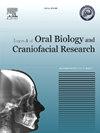Assessment of cytotoxicity of clear aligners coated with zinc oxide nanoparticles
Q1 Medicine
Journal of oral biology and craniofacial research
Pub Date : 2025-02-11
DOI:10.1016/j.jobcr.2025.01.010
引用次数: 0
Abstract
Background
Coating with nanoparticles can have clinical benefits like anti-bacterial activity and therefore an improvement in oral hygiene. However, the toxicity of these coatings is not known. The aim was to assess and compare the viability of human gingival fibroblasts (HGFs) of clear aligners coated with zinc oxide nanoparticles of different sizes.
Methods
Zinc oxide nanoparticles of 30 nm, 60 nm & 90 nm were sputter coated on five aligner samples and were compared with 5 uncoated samples. The thickness of the coating was standardized at 100 nm. The cytotoxicity on HGFs was assessed at day 0, 7 and 14 using assay ([3-(4,5-dimethylthiazol-2-yl)-2,5-diphenyl tetrazolium bromide]).
Results
The coated aligners exhibited “slight-cytotoxicity” on day 7 and day 14 compared to the uncoated aligners which were categorized as “no cytotoxicity”. Though the cell viability decreased in both the coated and uncoated aligners from day 0 to day 7 to day 14, this decrease was statistically significant for the coated aligners only. (p < 0.05) The greater cytotoxicity observed for the coated aligners was statistically significant only on day 14 (p < 0.001). Within the coated aligners, the 90 nm coating showed the least cytotoxicity, when compared with 60 nm and 30 nm at the time points measured, but this difference was significant only between the 90 nm and 60 nm group on day 14.
Conclusion
The mean decrease in cell viability for the uncoated aligner within the “no cytotoxicity range” while it was within the “slight cytotoxicity range” for the coated aligner. An increase in particle size demonstrated lesser cytotoxicity. ,.Zinc oxide coated aligners should be used with caution after day 7 even though there is only slight toxicity.
氧化锌纳米颗粒包覆透明对准剂的细胞毒性评价
纳米颗粒涂层具有抗菌活性等临床益处,因此可以改善口腔卫生。然而,这些涂层的毒性尚不清楚。目的是评估和比较涂有不同大小氧化锌纳米颗粒的透明对准器对人牙龈成纤维细胞(HGFs)的活性。方法:30 nm、60 nm、60 nm氧化锌纳米颗粒;在5个对准器样品上溅射涂覆90 nm,并与未涂覆的样品进行比较。涂层厚度标准化为100nm。采用[3-(4,5-二甲基噻唑-2-基)-2,5-二苯基溴化四唑]测定方法,在第0、7和14天对hgf进行细胞毒性评估。结果在第7天和第14天,包被矫正剂表现出“轻微的细胞毒性”,而未包被矫正剂则表现出“无细胞毒性”。虽然从第0天到第7天到第14天,包被和未包被的对准器的细胞活力都有所下降,但这种下降仅对包被的对准器有统计学意义。(p & lt;0.05)仅在第14天,涂层矫正器观察到的细胞毒性更大,具有统计学意义(p <;0.001)。在涂覆的对准器中,与60 nm和30 nm的涂层相比,90 nm的涂层在测量时间点上表现出最小的细胞毒性,但这种差异仅在第14天的90 nm和60 nm组之间显着。结论未包被的细胞活力下降在“无细胞毒性范围”内,包被的细胞活力下降在“轻微细胞毒性范围”内。颗粒大小的增加表明细胞毒性较小。,.即使只有轻微的毒性,也应在第7天之后谨慎使用氧化锌涂层矫正器。
本文章由计算机程序翻译,如有差异,请以英文原文为准。
求助全文
约1分钟内获得全文
求助全文
来源期刊

Journal of oral biology and craniofacial research
Medicine-Otorhinolaryngology
CiteScore
4.90
自引率
0.00%
发文量
133
审稿时长
167 days
期刊介绍:
Journal of Oral Biology and Craniofacial Research (JOBCR)is the official journal of the Craniofacial Research Foundation (CRF). The journal aims to provide a common platform for both clinical and translational research and to promote interdisciplinary sciences in craniofacial region. JOBCR publishes content that includes diseases, injuries and defects in the head, neck, face, jaws and the hard and soft tissues of the mouth and jaws and face region; diagnosis and medical management of diseases specific to the orofacial tissues and of oral manifestations of systemic diseases; studies on identifying populations at risk of oral disease or in need of specific care, and comparing regional, environmental, social, and access similarities and differences in dental care between populations; diseases of the mouth and related structures like salivary glands, temporomandibular joints, facial muscles and perioral skin; biomedical engineering, tissue engineering and stem cells. The journal publishes reviews, commentaries, peer-reviewed original research articles, short communication, and case reports.
 求助内容:
求助内容: 应助结果提醒方式:
应助结果提醒方式:


